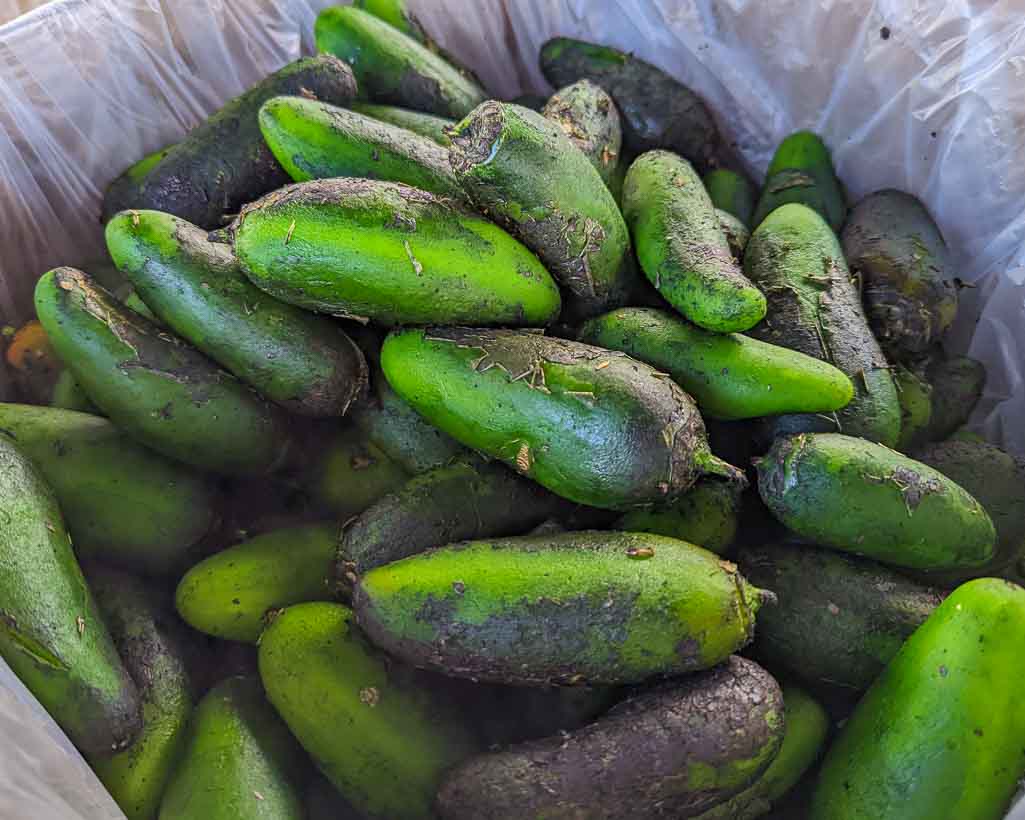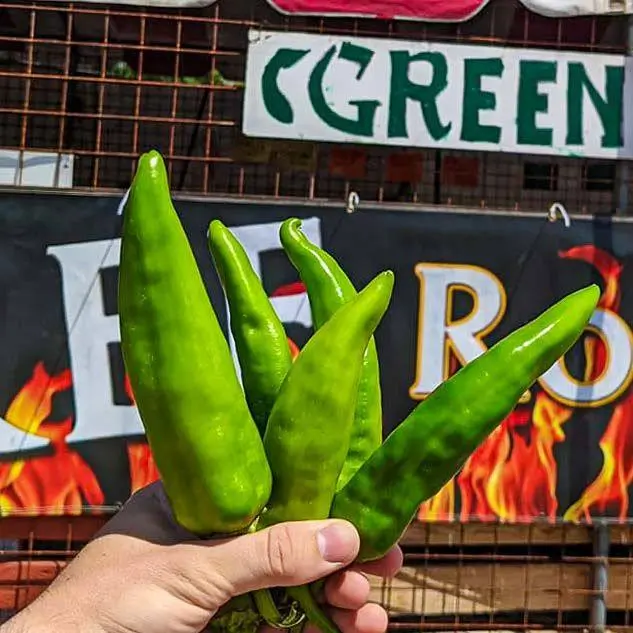Your cart is currently empty!
Ouch, My hands are burning! – All About Jalapeno Hands

What are Jalapeño hands?
This is a long and detailed article. If your hands are on fire NOW and need a fast answer, click here to skip down to how to soothe Jalapeño Hands!
If you have worked with spicy foods enough, you probably have had at least one time when your hands burned afterwards for hours. This long lasting burning feeling is commonly called jalapeño hands in English, and has caused a lot of pain to many home cooks, and even professional chefs after working with hot peppers. This is a common occurrance in New Mexico, particularly during the Hatch chile season, when New Mexicans take time to peel full 40 lb sacks of fresh roasted New Mexico chile. When working with Hot, extra hot, or the XXX-hot Lumbre chile, it is quite easy to get the burning sensation known as Jalapeno hands, or in this case a better name might be Hatch chile hands!
What causes the feeling of spice?
The feeling of spice is caused by capsaicinoids binding to TRPV1 receptors, also known as capsaicin receptors as they are the only receptor activated by Capsaicin according to Rosenbaum & Simon, 2007 . As these receptors are located throughout the nervous system, there are many more ways to experience spice than just eating food. Capsaicinoids produce a variety of effects, including sweating, vasodilation, and localized pain. There are different varieties of capsaicinoids in chili peppers that appear to have slightly different effects. The most famous one is Capsaicin, but there are other common types, such as Nordihydrocapsaicin and Dihydrocapsaicin which are almost as common in many chili pepper varieties. I won’t go too into the scientific details, but there is a great article up on the National Library of Medicine done by a team of researchers at Szent István University for those who like a hearty dose of chile science with their morning coffee like me!
How to prevent jalapeno hands?
Properties of Capsaicin
To understand this, it is important to know more about what causes the burning sensation in your hands. Capsaicinoids are oil like compounds that are hydrophobic by nature. This means they don’t mix with water. They bind to fats and alcohol, and will be picked up by emulsifiers like hand soap too. If you cut peppers and just rinse your hands with water, odds are it won’t have much preventative effect.
Wear Disposable gloves
If you have food preparation gloves available, wearing them when you work with spicy food is a great idea. In case you get your roasted Hatch chile at Farmers Chile Market, feel free to ask for a pair of gloves. We are happy to share, and would hate for your hands to burn after getting a sack of roasted chile from us! Even if you don’t have disposable gloves on hand, there are some things you can do to prevent a large heat buildup.
Wash Your Hands Frequently
Perhaps the best way besides a physical barrier between your skin and capsaicin is to frequently wash your hands with soap and warm water. The soap will bring the capsaicin oils up and allow them to be washed off by the warm water, which also increases the viscosity of the oily compounds to help wash them off your skin. If you do this immediately after cutting peppers, you might not have any problem. Just don’t forget the soap, as it is the most important part. Any regular hand soap will do, and dish soap also works just fine if it’s what you have on hand. If you are doing a simple dish with only a few peppers, washing your hands thoroughly at the end will be good enough. In case you are doing something which takes longer like peeling a sack of roasted Hatch green chile, wash your hands a few times during peeling as a preventative measure.
Avoid touching chili, especially the juicy parts
Another thing you can do is try not to touch the juicy parts of whatever you cut. If you are working with fresh, unblemished peppers, you can probably do a lot without getting juice on your hands. In general, the outside of an undamaged chile pepper doesn’t really have spice, but the inside, especially the membrane area where seeds are has a lot. When you cut a pepper, the spicy juices leak out and get on your hands. With more mild chile, it is ok to do more work with them. The spicier a chile is, the more you should consider other ways of processing them without using your hands too much. Scissors or a food processor is ideal for superhot stuff, but wash them thoroughly with soap after.
Prevention is the Best Solution
In case you are reading this while your hands are burning, damper your expectations. You can do things to lower the heat a little bit and reduce the length of the burning sensation. That being said, there are no really quick fixes.
How to soothe jalapeno hands after they start burning?
There are 3 main ways to do this, which I will outline first. Click to jump down to my personal method, which combines several of these!
Using oil
Time to get messy. Get some olive oil or some other kind of cooking oil, and rub it all over your hands for a minute or two. This will pull some amount of heat out of your skin and into the oil. After this, wash your hands thoroughly with soap and hot water. You will probably not feel any relief immediately, but this step is very helpful in shortening the time that your hands burn. Unfortunately, capsaicin that has penetrated the many layers of skin will not come out. You will still feel some burning for a while, but it will be significantly reduced by doing this.
Using Alcohol
If you pour a glass of cheap liquor and soak your hands in it, it will help to pull out spice. Similarly to using oil, you should wash your hands with soap and warm water after this to take off any spice that remains on the surface of your skin. Although rubbing alcohol is commonly suggested, it tends to evaporate very quickly. Capsaicin has a boiling point of 210 °C, so evaporation won’t help relieve the burn much. It needs to be sucked out by alcohol that won’t evaporate. Keep in mind that alcohol can also cause even more skin irritation, so don’t soak them for too long.
Using milk
Many people will recommend soaking your hands in cold milk, and this also will have some effect, but try using oil and washing with soap and water first. Milk helps pull out heat due to the casein proteins in milk which emulsify the fats naturally present in whole milk. The approximately 4% fat present in milk is another thing that capsaicin can dissolve into. Some people recommend buttermilk, but buttermilk is typically acidic, falling in the 4.4 to 4.8 pH range. “Casein proteins are heat-stable, but will denature below pH 4.6.,” according to The Rockefeller University. This is bad news for the effectiveness of milk, as one of the key aspects of its effectiveness in dissolving capsaicin is greatly reduced in most buttermilks.
Use your mouth
If you have hot spots on your hands somewhere, you can suck some of the heat off with your mouth, but this method takes a while and might gross out people around you. You will actually feel the heat in your mouth using this method, even after you use the other methods. The reason why, is that the previous methods are chemical methods without significant kinetic properties. They can’t really penetrate much further than the surface of your skin in a short amount of time. Suction is a more kinetic force which helps pull some of the capsaicin from deeper down. I’m not ashamed to admit that I’ve done this more than once.
My personal way to cut the burn
I use the oil and handwashing method first. I drip a bit of oil on my hands over the sink, so I can be gratuitous and not worry about making a mess. From there, I rub my hands together to mix up the oil and maximize contact with my skin and also increase the temperature to improve solubility of the capsaicin. I do this for about 3 to 5 minutes. After that, I wash my hands multiple times with plenty of soap, making sure to wash under my nails and in the cuticles as well. After that, I suck my fingers on the hot spots, which is the fastest way I know of to relieve lingering pain. My first time feeling the burn of jalapeño hands, it burned for at least four hours. Now, using this method it never lasts more that an hour or so.
Myths about Soothing Jalapeno Hands
Many websites talking about Jalapeño hands mention using lemon juice to neutralize capsaicin, because capsaicin is an alkaloid and lemon juice is acidic. The fact that so many hot sauces are vinegar based should quickly disprove this belief. Chili peppers are acidic to begin with too, which should further cast doubt on this spurious claim. There is actually research that shows acids can increase the effects of capsaicin, stating that “lowering pH resulted in a substantial increase in the magnitude of the current at the same capsaicin concentration,” Ryu et al., 2003. Because of this, I don’t recommend using lemon juice to sooth skin irritation caused by handling Jalapeño peppers or other spicy foods.
Don’t touch your eyes, and especially don’t touch your lover
Unless you want to cry harder than when you watched Titanic, keep your hands away from your face. Likewise, if you don’t want to sleep on the couch for the next month, keep them away from people you care about too. Many times, we underestimate just how much spice is on our hands, because it takes such a long time to penetrate the layers of skin and bind to a receptor that you can feel it.
Jalapeño hands and Hatch chile
People in New Mexico are quite prone to jalapeno hands, as a yearly tradition for many of us is peeling our sack of chile for the year. Because of this, I wrote this blog post to hopefully spare some people from a fiery feeling in their fingers this 2024 Hatch chile season! Remember the key points. If you have gloves, use them. If you don’t have gloves, wash your hands with soap a lot. Follow these key ideas so you don’t get jalapeno hands, even if you are peeling a sack of xxx-hot Lumbre chile. Happy peeling, enjoy your chile!
